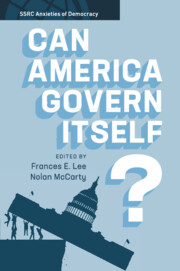Book contents
- Can America Govern Itself?
- SSRC Anxieties of Democracy
- Sponsored by the Social Science Research Council
- Can America Govern Itself?
- Copyright page
- Contents
- Acknowledgments
- 1 The Anxieties of American Democracy
- Part I Anxieties of Power, Influence, and Representation
- Part II Procedural Anxieties
- 7 Does Regular Order Produce a More Deliberative Congress?
- 8 Congress at Work
- 9 Dumbing Down?
- Part III Anxieties of Governance
- Index
- Index Authors
- References
7 - Does Regular Order Produce a More Deliberative Congress?
Evidence from the Annual Appropriations Process
from Part II - Procedural Anxieties
Published online by Cambridge University Press: 25 May 2019
- Can America Govern Itself?
- SSRC Anxieties of Democracy
- Sponsored by the Social Science Research Council
- Can America Govern Itself?
- Copyright page
- Contents
- Acknowledgments
- 1 The Anxieties of American Democracy
- Part I Anxieties of Power, Influence, and Representation
- Part II Procedural Anxieties
- 7 Does Regular Order Produce a More Deliberative Congress?
- 8 Congress at Work
- 9 Dumbing Down?
- Part III Anxieties of Governance
- Index
- Index Authors
- References
Summary
Calls for a return to a traditional method of lawmaking known as “regular order” have proliferated as unorthodox lawmaking has grown more dominant in Congress. Proponents claim regular order enhances deliberation on legislation. This chapter examines deliberation under one form of regular order: open rules permitting unlimited amending in the House of Representatives. We find evidence of substantial minority influence on the inputs and outputs of the appropriations process. Regular order gives the minority party members the opportunity to present and win adoption of their policy proposals. Our evidence also shows that ideological extremists play an outsized role in debate. They offer more amendments than other members, and their amendments tend to win less support and face defeat more often than moderates. The paradox of regular order is that it simultaneously offers the opportunity for bipartisan deliberation over legislation while exposing the majority party to problems that may make its management of the floor more difficult.
Keywords
- Type
- Chapter
- Information
- Can America Govern Itself? , pp. 154Publisher: Cambridge University PressPrint publication year: 2019

